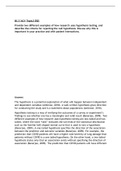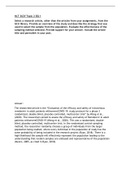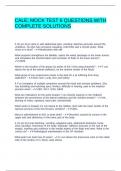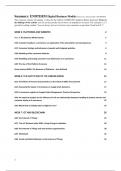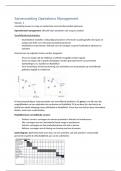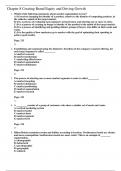SAMENVATTING ACCOUTING FOR MANAGERS
Chapter 1: The Manager and Manager Accounting
Accounting Discipline Overview
Accounting is the process to record, analyze, summarize, and interpret
nancial information of a business organization.
The generated accounting information is of use to the stakeholders of the
company (the employees, stockholders, creditors, banks and other lenders,
regulatory agencies and tax authorities, …). It is the only way or language
through which the organization can communicate with the internal and
external world. Two primary users of accounting information were previously
identi ed:
• Internal users.
• External users.
Each group uses accounting information di erently, and requires the
information to be presented di erently.
External users:
The recording of a company's financial history for use by outside entities is
commonly called financial accounting and is used for many purposes.
The external users of accounting information each have their own interests in
the company and want answers to unique questions.
• Creditors and Lenders. Should the company be granted a loan? Will the
company be able to pay its debts when they become due?
• Customers. Does the company o er useful products at fair prices? Will
the company survive long enough to honor its product guarantees?
• Government agencies. Does the company, like a local public utility,
charge a fair rate for its services?
Internal users:
Accounting supplies managers, owners, and employees with signi cant
nancial data that is useful for decision making. This type of accounting in
1
fi
fi fi ff ff ff
fi
, generally referred to as managerial accounting. In this course, we're not
going to focus on the external users.
We're focusing on those users inside of the organization, the managers and
employees who are making decisions that help the organization try to
achieve its goals.
Understanding accounting information is essential for managers to do their
jobs. Individual managers often require the information in an accounting
system to be presented or reported di erently. To simultaneously serve the
needs of all managers, companies create a database, sometimes called a
data warehouse or infobarn, consisting of small, detailed bits of information
that can be used for multiple purposes. Many companies are building their
own enterprise resource planning (ERP) systems. An ERP system is a
single database that collects data and feeds them into applications that
support a company’s business activities, such as purchasing, production,
distribution, and sales.
Overview accounting disciplines:
Management Financial accounting Cost accounting
accounting
Measures, analyzes, Focuses on reporting Measures, analyzes and
and reports nancial nancial information to reports nancial and
and non nancial external parties such as non nancial information
information that helps investors, governmental related to the costs of
managers make agencies, banks, and acquiring or using
decisions to ful ll suppliers, based on resources in an
organizational goals. GAAP. organization. Cost
Management accounting provides
accounting need not be information for both
GAAP compliant. management and
nancial accounting
professionals.
Managers use management accounting information to:
• Develop, communicate and implement strategies.
• Coordinate product design, production, and marketing decisions and
evaluate a company’s performance.
Example cost accounting:
• Calculating the cost of a product is a cost accounting function that meets:
• The nancial accountant’s inventory-valuation needs.
• The management accountant’s decision-making needs (such as deciding
how to price products and choosing which products to promote).
2
fi fifi fifi fi fi ff
, Businesspeople frequently use the term cost management. This term does
not have an exact de nition. We use the following de nition:
• Cost management = activities managers undertake to use resources in a
way that increases a product’s value to customers and achieves an
organization’s goals.
• Cost management is not only about reducing costs. Cost management
also includes making decisions to make additional costs - for example, to
improve customer satisfaction and quality and to develop new products -
with the goal of increasing revenues and pro ts. Whether or not to enter
new markets, implement new organizational processes, and change
product designs are also cost management decisions.
• Information from accounting systems helps managers to manage costs,
but the information and the accounting systems themselves are not cost
management.
Today most accounting professionals take the perspective that cost
information is part of the management accounting information collected to
make management decisions. Thus, the distinction between management
accounting and cost accounting is not so clear and these terms are used
interchangeably.
Major di erences between management and nancial accounting:
Note, however, that reports such as balance sheets, income statements, and
statements of cash ows are common to both management accounting and
nancial accounting.
3
fi ff fl fi fifi fi
, Strategic Decisions and the Management Accountant
Strategy speci es how an organization matches its own capabilities with the
opportunities in the marketplace.
• Strategy describes how an organization creates value for its customers
while distinguishing itself from its competitors.
• Strategy is the direction and scope of an organization over the long term,
which achieves advantage in a changing environment through its
con guration of resources and competences with the aim of ful lling
stakeholder expectations.
• Strategic decisions are made under conditions of complexity and
uncertainty; they have wide impact on the organization and often lead to
major change.
Strategic Management is the art and science of formulating, implementing,
and evaluating cross-functional decisions that enable an organization to
achieve its objectives. The competitive advantage is the attribute that
allows an organization to outperform its competitors. There are two broad
strategies that might lead to competitive advantage: cost leadership and
product di erentiation.
• Cost leadership refers to a company's ability to create economies of scale
through highly e cient operations that produce a large volume. Cost
leaders are organizations such as Walmart, McDonald's and other large
companies that produce a large volume of goods that are distributed at
relatively low cost (compared to the competition).
• Product di erentiation refers to a company's ability to create a good that
is di cult to replicate, and thereby ful lling niche needs. This strategy can
include creating a powerful brand image that allows the organization to sell
its products or services at a higher price than the less-popular products or
services of their competitors. Mercedes is a good example of
di erentiation.
Strategic cost management describes cost management that focuses
speci cally on strategic issues.
• Deciding between the two broad strategies of cost leadership or product
di erentiation is a critical part of what managers do.
• Management accountants work closely with managers in various
departments to formulate strategies by providing information about the
source of competitive advantage, such as (1) the company’s cost,
productivity or e ciency advantage relative to competitors or (2) the
premium prices a company can charge over its cost for distinctive product
or service features.
4
ff fiffifi
ff fiffi fi fi
Chapter 1: The Manager and Manager Accounting
Accounting Discipline Overview
Accounting is the process to record, analyze, summarize, and interpret
nancial information of a business organization.
The generated accounting information is of use to the stakeholders of the
company (the employees, stockholders, creditors, banks and other lenders,
regulatory agencies and tax authorities, …). It is the only way or language
through which the organization can communicate with the internal and
external world. Two primary users of accounting information were previously
identi ed:
• Internal users.
• External users.
Each group uses accounting information di erently, and requires the
information to be presented di erently.
External users:
The recording of a company's financial history for use by outside entities is
commonly called financial accounting and is used for many purposes.
The external users of accounting information each have their own interests in
the company and want answers to unique questions.
• Creditors and Lenders. Should the company be granted a loan? Will the
company be able to pay its debts when they become due?
• Customers. Does the company o er useful products at fair prices? Will
the company survive long enough to honor its product guarantees?
• Government agencies. Does the company, like a local public utility,
charge a fair rate for its services?
Internal users:
Accounting supplies managers, owners, and employees with signi cant
nancial data that is useful for decision making. This type of accounting in
1
fi
fi fi ff ff ff
fi
, generally referred to as managerial accounting. In this course, we're not
going to focus on the external users.
We're focusing on those users inside of the organization, the managers and
employees who are making decisions that help the organization try to
achieve its goals.
Understanding accounting information is essential for managers to do their
jobs. Individual managers often require the information in an accounting
system to be presented or reported di erently. To simultaneously serve the
needs of all managers, companies create a database, sometimes called a
data warehouse or infobarn, consisting of small, detailed bits of information
that can be used for multiple purposes. Many companies are building their
own enterprise resource planning (ERP) systems. An ERP system is a
single database that collects data and feeds them into applications that
support a company’s business activities, such as purchasing, production,
distribution, and sales.
Overview accounting disciplines:
Management Financial accounting Cost accounting
accounting
Measures, analyzes, Focuses on reporting Measures, analyzes and
and reports nancial nancial information to reports nancial and
and non nancial external parties such as non nancial information
information that helps investors, governmental related to the costs of
managers make agencies, banks, and acquiring or using
decisions to ful ll suppliers, based on resources in an
organizational goals. GAAP. organization. Cost
Management accounting provides
accounting need not be information for both
GAAP compliant. management and
nancial accounting
professionals.
Managers use management accounting information to:
• Develop, communicate and implement strategies.
• Coordinate product design, production, and marketing decisions and
evaluate a company’s performance.
Example cost accounting:
• Calculating the cost of a product is a cost accounting function that meets:
• The nancial accountant’s inventory-valuation needs.
• The management accountant’s decision-making needs (such as deciding
how to price products and choosing which products to promote).
2
fi fifi fifi fi fi ff
, Businesspeople frequently use the term cost management. This term does
not have an exact de nition. We use the following de nition:
• Cost management = activities managers undertake to use resources in a
way that increases a product’s value to customers and achieves an
organization’s goals.
• Cost management is not only about reducing costs. Cost management
also includes making decisions to make additional costs - for example, to
improve customer satisfaction and quality and to develop new products -
with the goal of increasing revenues and pro ts. Whether or not to enter
new markets, implement new organizational processes, and change
product designs are also cost management decisions.
• Information from accounting systems helps managers to manage costs,
but the information and the accounting systems themselves are not cost
management.
Today most accounting professionals take the perspective that cost
information is part of the management accounting information collected to
make management decisions. Thus, the distinction between management
accounting and cost accounting is not so clear and these terms are used
interchangeably.
Major di erences between management and nancial accounting:
Note, however, that reports such as balance sheets, income statements, and
statements of cash ows are common to both management accounting and
nancial accounting.
3
fi ff fl fi fifi fi
, Strategic Decisions and the Management Accountant
Strategy speci es how an organization matches its own capabilities with the
opportunities in the marketplace.
• Strategy describes how an organization creates value for its customers
while distinguishing itself from its competitors.
• Strategy is the direction and scope of an organization over the long term,
which achieves advantage in a changing environment through its
con guration of resources and competences with the aim of ful lling
stakeholder expectations.
• Strategic decisions are made under conditions of complexity and
uncertainty; they have wide impact on the organization and often lead to
major change.
Strategic Management is the art and science of formulating, implementing,
and evaluating cross-functional decisions that enable an organization to
achieve its objectives. The competitive advantage is the attribute that
allows an organization to outperform its competitors. There are two broad
strategies that might lead to competitive advantage: cost leadership and
product di erentiation.
• Cost leadership refers to a company's ability to create economies of scale
through highly e cient operations that produce a large volume. Cost
leaders are organizations such as Walmart, McDonald's and other large
companies that produce a large volume of goods that are distributed at
relatively low cost (compared to the competition).
• Product di erentiation refers to a company's ability to create a good that
is di cult to replicate, and thereby ful lling niche needs. This strategy can
include creating a powerful brand image that allows the organization to sell
its products or services at a higher price than the less-popular products or
services of their competitors. Mercedes is a good example of
di erentiation.
Strategic cost management describes cost management that focuses
speci cally on strategic issues.
• Deciding between the two broad strategies of cost leadership or product
di erentiation is a critical part of what managers do.
• Management accountants work closely with managers in various
departments to formulate strategies by providing information about the
source of competitive advantage, such as (1) the company’s cost,
productivity or e ciency advantage relative to competitors or (2) the
premium prices a company can charge over its cost for distinctive product
or service features.
4
ff fiffifi
ff fiffi fi fi


